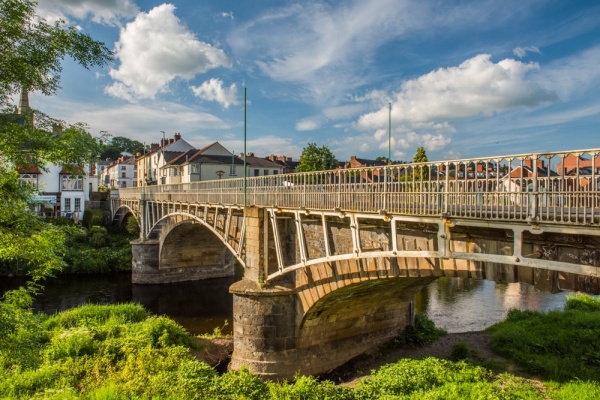
Newton, or Y Drenewydd in Welsh, is the largest town in Powys. Newtown sits astride the River Severn in beautiful countryside about 14 miles from Welshpool.
History
Newtown is traditionally said to have begun in 1279 when Edward I granted his ally Roger de Mortimer, Earl of Wigmore, the right to establish a new market town in the strategically important region of Cedewain in Mid Wales.
De Mortimer chose to build his 'new town' near a riverside chapel dedicated to St Mary, close to the westernmost edge of his lands (possibly to prevent a neighbouring lord from establishing a competing market town nearby). There may have been a small settlement surrounding the chapel, which was a daughter chapel of the older and larger church at Llanllwchaiarn.
The story really begins much earlier, however, in the turmoil of the Baron's War, across the border in England, when Simon de Montfort led his allies against Henry III. During the upheaval in England Llewelyn ap Gruffydd ('Llewelyn the Last') took advantage of the situation to seize lands in eastern and central Wales that had belonged to his relative Roger de Mortimer. Llewelyn's bold move culminated in the 1267 Treaty of Montgomery, where the English crown recognised him as ruler of a vast area extending from Gwynedd to Brecon and including Powys.
After Henry III's death in 1272 Llewelyn established a castle at Dolforwyn with a new settlement and market. It was a provocative act; castles and markets were vital strategic elements and the right to create them was jealously guarded by the English crown. The new English king, Edward I, immediately declared Dolforwyn illegal, prompting Llewelyn to say that it was his land and he would do as he pleased.
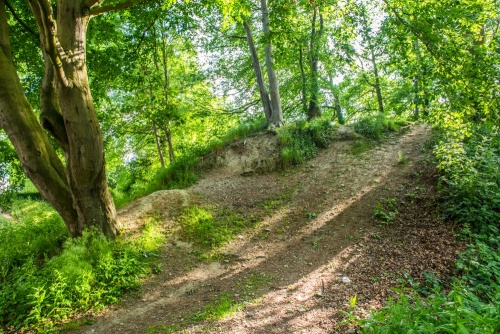
Edward declared Llewelyn a rebel and used his actions as an excuse to invade Wales. The invasion eventually ended with all of Wales under English control.
Among Edward's allies in the invasion was Roger de Mortimer, who must have taken great satisfaction in leading the attack on Dolforwyn himself. The castle fell in 1277 and as a reward, Edward granted him the castle and the lands that Llewelyn had seized in Powys.
Rather than rebuilding Dolforwyn Castle and the surrounding settlement, Mortimer decided to build a new town down in the valley, siting it on the important river route into the Welsh heartland. The medieval street layout established by Mortimer is still evident today.
To protect his new town Mortimer erected a motte and bailey fortification. You can still climb the overgrown banks of the castle motte, located in the Park near the County Council Offices (the former Newtown Hall). The earthwork banks that defended the motte are more scanty but you can still trace them in places.
In addition to granting Roger de Mortimer the right to establish a castle and weekly market, Edward I's charter allowed Mortimer to hold 2 annual fairs. The fairs and the regular market helped establish Newtown as a centre of commerce for Powys.
As the town grew in importance St Mary's Church became independent of Llanllwchaiarn. The town grew throughout the medieval period as a market centre, but was still relatively small, with just 55 taxpayers listed in 1545.
But that period of relative calm changed dramatically in the 19th century when Newtown became a centre of the textile trade. A handloom weaving industry flourished, but then in 1819 the Montgomeryshire Canal arrived in Newtown, signalling a period of explosive growth.
Factories sprouted up, with fulling mills, bleaching grounds, a foundry, tanneries and potteries established near the river. The town quickly outgrew its Norman boundaries and by 1841 Newtown had a population of 4,500.
Newtown Textile Museum
You can trace the history of the weaving industry in the Textile Museum in Penygloddfa, on the north side of the river. The museum occupies a former handloom weaving factory built in the 1830s. Old worker's cottages have been restored, while the top two floors of the museum explore the journey of woollen fleece as it is processed and woven to create flannel cloth. The museum also showcases demonstrations of spinning, weaving, and quilt making.
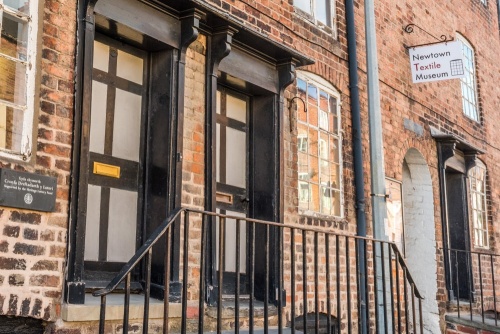
The burgeoning textile trade may have produced great wealth but it also created great hardship among the working classes. One of those who sought to create a better life for the labouring classes was Newtown native Robert Owen.
Robert Owen Birthplace
Owen was born at No. 2 Broad Street, on the site now occupied by the HSBC bank, on 14 May 1771. His father was an ironmonger and saddler, and Robert was the sixth of seven children. A plaque on the exterior of the building commemorates the birthplace but to really gain an appreciation of Owens' life you have to cross the street to the free museum dedicated to this remarkable man.
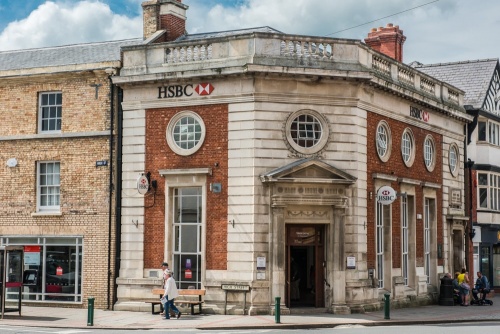
Robert Owen Memorial Museum
This wonderful little museum tells the story of Owen's life and is appropriately housed in a building that was erected in 1902 as a free public library. The beautiful arts and Crafts style architecture makes the museum building worth attention in its own right. Within the museum are personal artefacts, letters, portraits, and a wealth of information on Robert Owen and his work to create a more just and equitable society.
More about the Robert Owen Memorial Museum >>
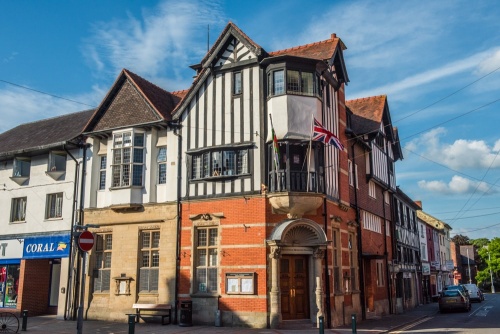
Robert Owen Park & Statue
A short stroll from the museum is a small park dedicated to Owen. There you will find a memorial statue by sculptor Gilbert Bayes of Robert Owen, with his cloak partially protecting an urchin at his feet. The statue was commissioned by the residents of Newton in the 1950s, who raised an astonishing £2,000. Bayes died before completing his sculpture and the work was finished by WE King, a former President of the Royal Society of Sculptors. A replica stands in front of the Co-operative Bank in Balloon Street in Manchester as a reminder of how Owens' ideals influenced the Co-operative movement.
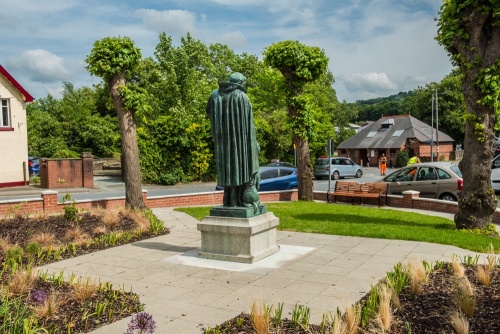
St Mary's Church
In 1856 the medieval church of St Mary's that had predated the town itself was abandoned due to flooding. The roofless church stands in a lovely park setting beside the river, now protected from the effects of the floods that forced its abandonment. The layout is unusual, with a double nave. The west tower was restored in 1939.
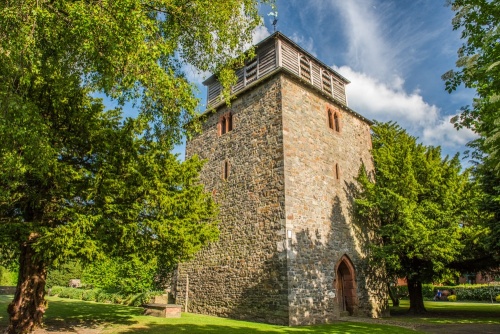
Robert Owen's Tomb
Outside the south wall of the church is the ornate tomb of the social reformer Robert Owen, the most famous native of Newtown. Owen died in 1858, just two years after the church had been abandoned. It is likely that the churchyard was in poor condition at the time due to the effects of flooding but Owen expressed a wish to be buried at St Mary's because his parents were also interred there.
The original grave was a modest one, but in 1900 George Holyoake, one of Owen's fellow social reformers, declared that it was a poor memorial to so great a man. He and his supporters raised 1,500 pounds to renovate the memorial.
The fairly plain table tomb is surrounded by magnificent Art Nouveau iron railings, with a tableau by Alfred Toft, showing Owen surrounded by labourers. The memorial is inscribed with Owen's words, 'It is the one great and universal interest of the human race to be cordially united and to aid each other to the full extent of their capacities'.
As you explore Newtown you will come across other reminders of Robert Owen. Close to Owen's house is the Bear Lanes shopping centre. The centre stands on the site of the Bear Inn, where Owen died. Across Wesley Street from the shopping centre, you can see a large bronze plaque depicting scenes from Owen's life.
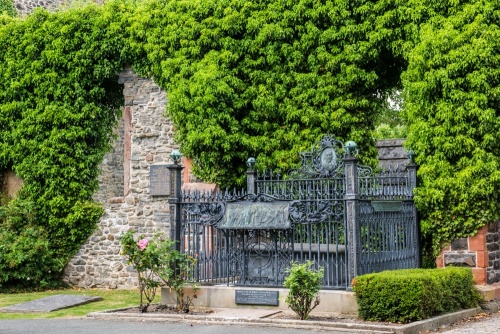
Historic Places around Newtown
There is much more to Newtown than its favourite son. Here are some of the historic places you will run across as you explore the town.
WH Smith Museum
On High Street, just around the corner from the Robert Owen birthplace, is the WH Smith booksellers. That in itself is unremarkable; you can find a WH Smith in most towns in Britain. This shop is different, however, for behind the elegant inter-war facade is not simply a bookstore but a time capsule of an early 20th century shop. The story behind this unusual museum goes back to the 1970s when the WH Smith company decided to modernise all their outlets. All but one.
The company decided to leave one shop unaltered, to act as a permanent reminder of what the shops used to look like. So the Newtown shop was restored to the way it looked when it first opened its doors in 1927, with its original tiles, mirrors, oak shelving, 1920s light fixtures, a pair of Victorian-style skylights, and an oak staircase.
The first floor, once a WH Smith lending library, was converted into a company museum tracing the story of the WH Smith company from its origins in 1792 to the present day. Learn how William Henry Smith rose from humble origins as the son of a London newspaper carrier to create a family business that now spreads across the world.
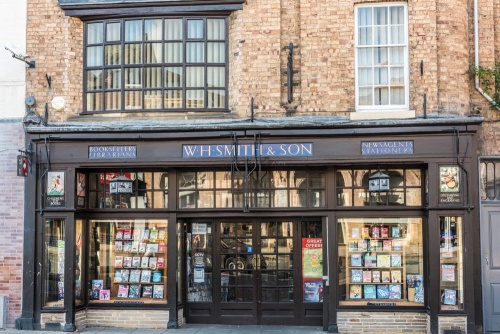
Bank Cottages
Tucked away on The Bank, around the corner from the Robert Owen Park and Statue, are Bank Cottages, a cluster of picturesque thatched and timber-framed buildings dating to the late Tudor period. One part of the building has been converted into a popular tearoom where you can enjoy refreshments in historical surroundings.
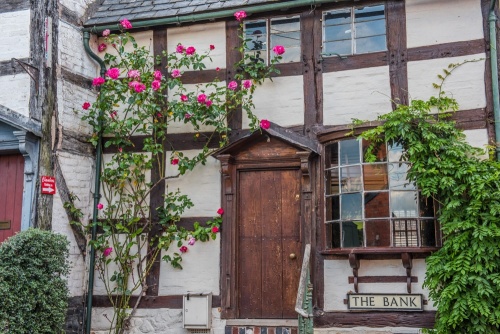
Market Hall
Between Market Street and High Street is the Market Hall, a restored Victorian market built in 1870. The exterior looks much as it did then, but the interior has been completely renovated as a combination market and community space.
Old Flannel Exchange
At the west end of Broad Street, just before the bridge is this early Victorian building designed by the County Surveyor, Thomas Penson in 1832. The Exchange was designed in a combination of Art Deco and Greek Revival style, with two storeys atop a basement and plaster on brick exterior decoration.
The Exchange was a project by local merchants intent on taking some of the lucrative flannel trade from nearby Welshpool. In 1890 one end of the building was used by the Post Office. The building was converted to become a cinema after WWI and after several refurbishments is now an entertainment venue housing a cinema and nightclub.
Town Clock
On High Street, across from the Robert Owen Museum, is the Clock Tower, perhaps the most iconic sight in Newtown. The Clock Tower was begun in 1898 to commemorate Queen Victoria's Diamond Jubilee, which had taken place the year before. The person behind the tower was Sarah Brisco, a descendant of the Pryce family, owners of Newtown Hall. The town clock (not the tower) was given to the people of Newtown in 1900.
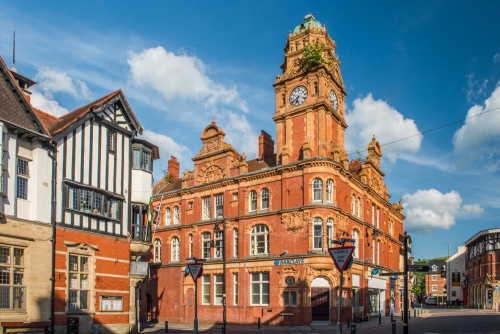
Cenotaph
At the junction of New Road and Shortbridge Street, marooned on a triangular green surrounded by traffic whizzing by, is the town Cenotaph, erected in 1924. The Cenotaph is made of Portland stone and cost 500 pounds to build. It was unveiled in the presence of the Lord Lieutenant of Montgomeryshire in 1925. The Cenotaph commemorates the 144 soldiers who died in WWI. After WWII a further 42 names were added. The green on which the Cenotaph stands has been dedicated as a Memorial Garden.
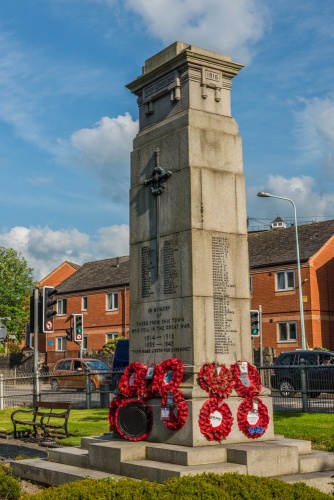
Baptist Chapel
This beautiful neoclassical building looks more like an elegant town hall than a church. The chapel stands at the corner of New Church Street and New Road. It was designed in 1881 by George Morgan of Carmarthen and cost over £8,000. The striking exterior is a combination of Corinthian columns under a Dutch gable.
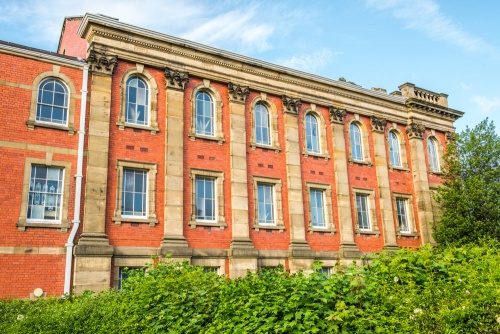
St David's Church
From the Chapel you can look across New Road to St David's Church, built in 1843 to replace St Mary's Church as mentioned above. This imposing Victorian structure is still one of the most beautiful buildings in Newtown. It, too, was designed by County Surveyor Thomas Penson, at a cost of 4,600 pounds. It was restored in 1874 by David Walker of Liverpool at a cost of 3,000 pounds.
Inside are monuments removed from St Mary's Church including a 1739 memorial to the wives of Sir John Pryce of Newtown Hall. The 15th-century parclose screen was brought from St Mary's as was the 13th-century font and 18th-century candelabra.
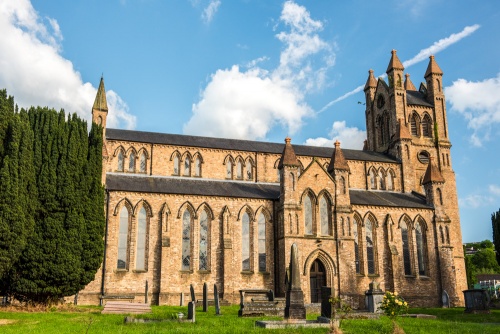
Rail Station
The Newtown Rail Station was built in 1863 and is a very good example of a mid-Victorian station house. It originally acted as the terminus of a line from Machynlleth.
Royal Welsh Warehouse
Pryce Jones, the founder of the world's first mail-order business, opened his Newtown warehouse beside the station in 1879, taking advantage of the transportation links to speed his business transactions. The architect was David Walker of Liverpool, who also worked on St David's Church (above). The building was extended in 1886 and a new wing added in 1901. The new wing included its own post office to handle the huge number of incoming postal orders. The building is now in use as a department store and is listed Grade II for its historic value.
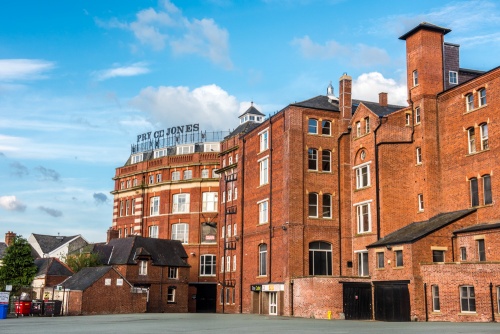
Agricultural House
Opposite the Warehouse is Agricultural House, built in 1895 as a factory for Pryce Jones, replacing an earlier building on the same site. A bridge linked the Agricultural Building with the 1901 extension to the Royal Welsh Warehouse. The building was taken over by the Admiralty in WWII and later by the Agricultural Executive Committee. It is a strikingly beautiful example of a late Victorian industrial building with alternating bands of different coloured brick under a gabled slate roof.
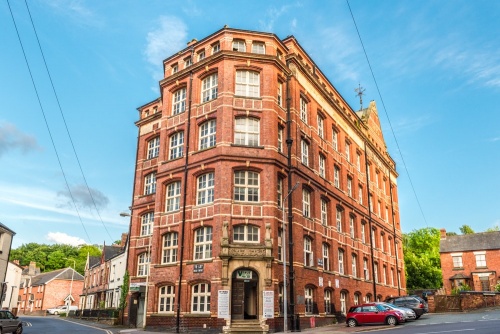
Oriel Davies Gallery
Not quite so historic but certainly worth a visit is the Oriel Davies Gallery, beside the main town car park. The Gallery is a contemporary visual arts venue, with exhibits by national and international artists in a free, family-friendly venue. The gallery plays host to 10 exhibitions each year from work by established artists to breakthrough works by emerging artists. There is an ongoing programme of workshops, art courses, talks and special events.
Outside Newtown
Dolforwyn Castle
This hilltop fortification was built c. 1273 by Llewelyn the Last and was surrounded by a planned town. It was here in 1277 that Roger de Mortimer launched the attack that would eventually end with Edward I of England claiming lordship of Wales. The castle ruins include a circular tower, the largest built by a Welsh ruler, and a rectangular keep surrounded by curtain walls.
More about Dolforwyn Castle >>
Gregynog Hall and Garden
In beautiful countryside north of Newtown stands Gregynog Hall, a Victorian mansion built around a medieval manor house. In 1920 Gregynog was purchased by Margaret and Gwendoline Davies, who transformed it from a country house to a centre for the arts. They also launched the Gregynog Festival, the oldest music festival in Wales. The house is now run as an education centre by the University of Wales. It stands in a superb 750 acres of historic gardens, some of which date to the 16th century.
More about Gregynog Hall >>
About Newtown
Address: Newtown,
Powys,
Wales
Attraction Type: Town
Location: At the junction of the A483 and A489, 11 miles south-west of Welshpool. There is a large and well-signposted visitor parking area off Back Lane.
Website: Newtown
Location map
OS: SO108916
Photo Credit: David Ross and Britain Express
HERITAGE
 We've 'tagged' this attraction information to help you find related historic attractions and learn more about major time periods mentioned.
We've 'tagged' this attraction information to help you find related historic attractions and learn more about major time periods mentioned.
Find other attractions tagged with:
NEARBY HISTORIC ATTRACTIONS
Heritage Rated from 1- 5 (low to exceptional) on historic interest
Robert Owen Memorial Museum - 0 miles (Museum) ![]()
St Mary's Church & Robert Owen's Grave - 0.1 miles (Historic Church) ![]()
Newtown Hall Castle Motte - 0.2 miles (Castle) ![]()
Dolforwyn Castle - 3.4 miles (Castle) ![]()
Gregynog Hall & Gardens - 4 miles (Historic House) ![]()
Caersws Roman Forts - 4.9 miles (Roman Site) ![]()
Andrew Logan Museum of Sculpture - 7.4 miles (Museum) ![]()
Castell y Blaidd (Wolf's Castle) - 7.4 miles (Castle) ![]()



